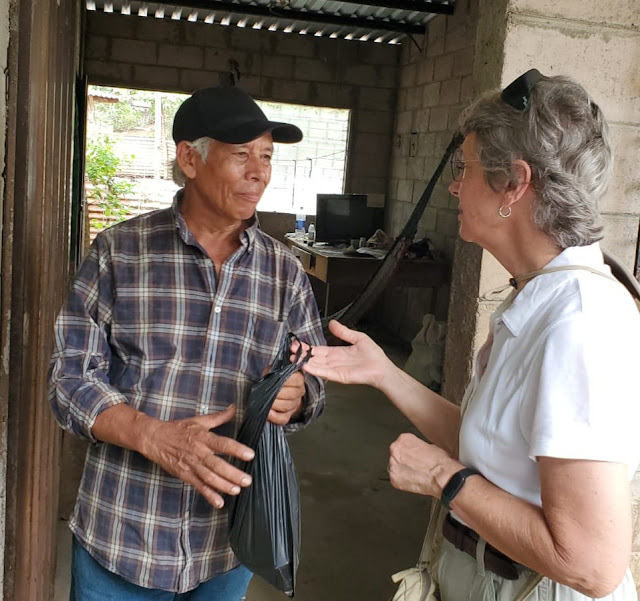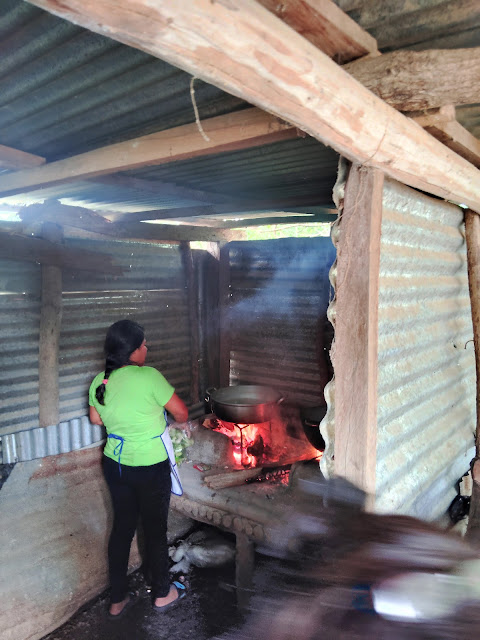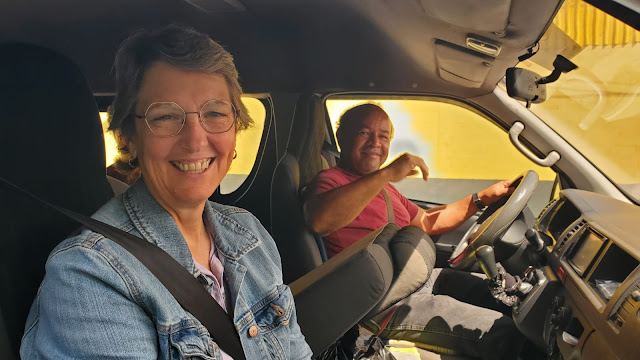El Salvador Delegation 2025: Day 7
June 23, 2025
After breakfast, the Heartland people had a short meeting with Blanca and Elmer (as members of the Pastoral Team) about El Tablon's priorities and needs. I was there but not participating because Heartland's partnership with El Tablon is their relationship to manage. I'm not a member of either group. I'm on this delegation in my capacity as an Our Sister Parish board member and officer.
We loaded up the truck one last time for the drive to El Tablon. We drove to Antonio's house in Tablon Centro and unloaded the packages to deliver and the people going house-to-house. Then the truck and the rest of the supplies went down to the school at Tablon Cerna, where we would have lunch and party with the community in the afternoon.
My group visited 8 houses, all down the mountain from where we started. We eventually caught up with the other group at their last house. Then, we all continued our walk down to the school for lunch.
 |
| This was one of the men who got so choked up when we gave him the health, soap, and food bags. I'm giving him the health bag. |
At the school, the morning classes were just finishing up. We had some toys and games for the school but they were on the truck, which had to go back to the Casa to get the party supplies and wasn't back yet. We didn't want to keep the teachers and students longer than we had to so the Heartlanders went to meet with them to tell them about the toys. But then the truck arrived and they could actually show them the soccer balls, frisbees, smaller play balls, jacks sets, jump ropes, etc. They explained that these were for the school to keep and the kids to play with during play time while they were there. One of the teachers got down on the floor to demonstrate how to play jacks. He was really good at it!
 |
| One of the teachers showing the kids how to play jacks. |
We had lunch, which had been prepared at the school kitchen by Cecilia and some women from the community. With Cecilia in charge, we could trust that the food would be safe for our North America digestive tracts.
 |
| Cooking our lunch inside the school kitchen. |
 |
| Preparing the "snacks" for the community members in the school kitchen prep area. |
It sprinkled a couple of times while we were at the school, but never enough to be a real issue. We had the shelter of the school roof, if it had.
Around 1:00, the community members started arriving...all of them from both Centro and Cerna. We had a wrap-up meeting where people could say something if they wanted. There were a lot of thanks and expressions of gratitude for visiting their homes. That was a really big deal for people...that we had gone to the effort to come to El Salvador and meet with them personally, talk with them individually, see them as people living their lives. We thanked them for opening their homes and lives to us, taking time away from the fields (in some cases) and sharing their stories and realities with us.
Then there was a covenant signing. The partnership model for communities and their partner churches calls for a covenant to be signed at the inception of the partnership and then again every 5 years after that. It was time to re-up the Cerna partnership with Heartland and the Centro group was new so it was their first covenant. There were 4 copies of the covenant for Centro and 4 for Cerna, 1 copy of each for: the community, the Pastoral Team, Heartland, and Our Sister Parish. One representative of each group signed all documents; I signed for Our Sister Parish.
.jpg) |
| Our translator, Oscar, read the entire covenant aloud so that everyone knew what they were agreeing to. The covenant spells out the responsibilities of each group and when it is due to be signed again. The table in the foreground is where we signed all 8 copies. |
Once the business was taken care of, it was time for the party! We brought 4 piñatas, one each for the girls, the boys, the men, and the women. The kids weren't blindfolded, but the adults were. As the piñata would move up and down, people would yell out "Arriba!" (up) or "Abajo" (down) to 'help' the blindfolded person find it. Mary represented the delegation in the women's category and cracked open their piñnata.
 |
| This little girl couldn't get enough of a whack to do more than move the piñata a little, but she had a good time trying. |
 |
| Some of the little kids can really whack it. |
 |
| These enterprising boys decided to check the discarded piñatas for any candy that may not have fallen out. They were well rewarded for their ingenuity. |
 |
| Elmer "drove" the piñatas for the kids. |
After all the piñatas had given up their contents, all the community members got a sandwich. I didn't see what was in the sandwiches but they were made with a long lozenge shaped roll that had been slit across the top and stuffed with something.. They also got a bottle of pop (the big flavors are grape and orange, although I saw some strawberry, too) and a package of Oreo-type cookies.
Then it was pack-up, clean-up time. A guy with a shop broom swept up the detritus of the piñatas. So many people wanted to have their picture taken with one or more of us. So many people wanted to say "goodbye" and hug us. It took a while to actually get into the truck and on the road.
The truck was packed, as many of the Centro people wanted a ride up the mountain to their community. There was a woman standing behind me holding an infant. It was all I could do to hold on with 2 hands on the rough, very bumpy road. I couldn't imagine how she was hanging on with only one hand and holding a baby with the other. I was so afraid of lurching into her that I had a death grip on the bars and my hands started to tingle.And then the baby fell asleep, so the woman was pretty much holding inert weight.
 |
| When we first go in the truck, the baby was alert. |
 |
| But he very quickly fell asleep. The photo was taken during a brief stop to let off some people. She continued on not only hanging on with one hand, but standing on one foot. |
Almost all the people got off somewhere around Cerna. The exception being 2 grade-school age kids, a brother and sister. They stayed on long past any Cerna houses and we wondered if they were going all the way to Berlín with us. The answer was, "Yes." Apparently, their mother works in Berlín and they were going to ride with us. We stopped and they got out around the cemetery.
We got back to the Casa around 4:45 then left again for Alegría at 5:00. It's traditional for delegations to take the Team out to dinner on the last night. More standing in the back of the truck... At least this time, we're on paved roads so it's a whole lot smoother. It spit rain on us a little on the way there but I was standing behind Mike and he blocked all the wind and rain for me. Thanks, Mike!We went to a restaurant called Finca Margarita that sits very high over Alegría and has a phenomenal view down the mountain and into the valley. If the weather is clear. It wasn't exactly clear for us, but it's still a very cool place with good food.
 |
| At Finca Margarita, this is an overlook point called the Door to Heaven. Great views but those of our group who don't like heights, declined to climb the stairs. |
 |
| The path down from the Door to Heaven. There is a little cafe up there where you can get coffee and sweets, but we didn't partake as we were waiting for our food down at the restaurant. |
Back at the Casa, Luann (our group treasurer) figured up how much budgeted money we had left and then we, as a group, discussed what to do with it. It's always the group's choice what to do with it. We could choose to divide it among the delegates or contribute it to some purpose locally. We had $390 left and decided to give $100 to the Heartland Health Fund (which was nearly empty) and the rest to Heartland's general fund for future food packets.
I went to my room around 9 and got mostly packed. Home tomorrow!




























.jpg)







